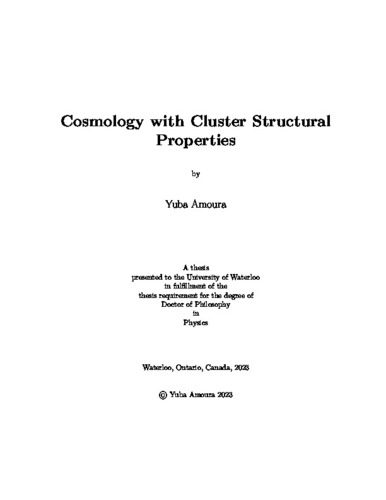| dc.description.abstract | Galaxy clusters are massive objects composed of hundreds or thousands of galaxies, hot gas and an extended dark matter (DM) halo. They are the largest gravitationally bound structures in the Universe. As such, they result from the growth and collapse of the highest peaks in the density perturbation field. Because fundamental properties of the Universe determine the statistics and evolution of those peaks, clusters can be used for cosmology. The most common method to do that is to use their abundance, which requires counting them in bins of mass and redshift (distance). The main challenge in using this method is accurately estimating their mass through observational proxies. This method has the advantage of requiring only the mass and redshift of each cluster, but neglects other cluster properties that could contain cosmological information. Since clusters are complex multi-component objects that can be detected in optical, X-ray, and radio wavelengths, a wealth of information is discarded and compressed into a single mass estimate. Moreover, the abundance of clusters is influenced in the same way by increased power in the initial spectrum of density fluctuations, or by increased growth at later times. This induces a degeneracy in estimates of the amount of matter in the Universe $\Omega_m$---governing the growth---and how ``clumpy" the matter distribution is, $\sigma_8$---governing the height of initial peaks.
In this thesis, I explore another way to exploit clusters to gain cosmological insight. Inspired by original work from \citet{Richstone1992}, \citet{Evrard1993} and \citet{Mohr1995}, I study how clusters' structural properties and dynamical state can provide useful constraints on $\Omega_m$ and $\sigma_8$.
In the first part of this thesis, I study how cluster formation time varies as a function of $\Omega_m$ and $\sigma_8$ through analytical models and DM-only simulations, and find that cluster age constraints are almost orthogonal to typical abundance and structure-growth ones. Moreover, the formation redshift varies by a factor of 2 from one end to the other of the relevant part of the $\Omega_m$ and $\sigma_8$ plane. Using cluster concentration as a tool to measure age, we would need about 10,000 clusters to get measurements of $\sigma_8$ up to 1\% accuracy.
I continue in the second part to study the cosmological dependence of cluster and dark matter halo dynamical states but focus on the instantaneous equivalent of age, specifically, the halo growth and merger rates. Here again, I use analytical models and DM-only simulations and find that growth rates' dependence on $\Omega_m$ and $\sigma_8$ is also orthogonal to cluster abundance constraints. However, the sensitivity is weaker in this case, ranging between 60\% to 90\%. Using cluster and galaxy growth and merger rates becomes challenging when considering the current scatter in observational measurements.
Finally, the last part of this thesis is to link the dynamical state of haloes to their structural properties in detail. I use a set of high-resolution simulations that I have run for different cosmologies to study what information is contained in the accretion history of haloes, and show that the mass accretion history (MAH) of haloes is mainly a one-dimensional quantity. Moreover, a halo's age is well-described by its state during the middle of its growth, such as the time it reaches 50\% of its final mass $z_{50}$.
The halo concentration and the offset between the centre-of-mass and peak of the density contours are particularly good age predictors when used individually. If we use them together and/or with another structural property, such as shape, they become even better by reducing scatter in individual relations and segregating very young and very old halo populations.
In conclusion, in this thesis, I show how we can use cluster structural properties to constrain $\Omega_m$ and $\sigma_8$. First, I show how cluster age and growth rate vary with cosmology, and then how age correlates with cluster structural properties. | en |

